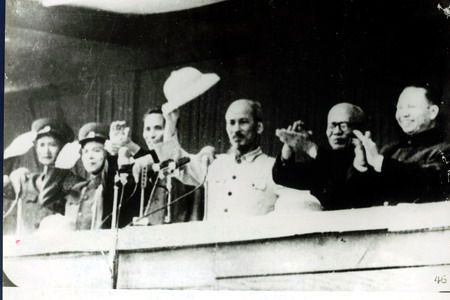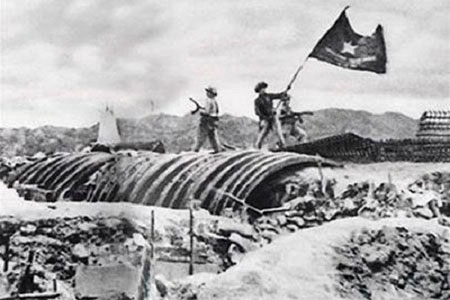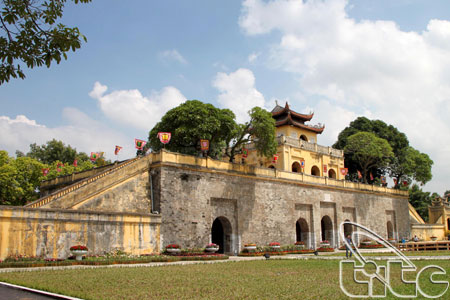In the summer of 1945, popular discontent reached a climax and revolutionary action involving both political and armed struggle proliferated throughout the country, from north to south, in villages and cities, and among the ethnic minorities in the mountainous regions.


The decisive factor was the Viet Minh Front which led and coordinated all the actions nationwide.
On August 13, following the defeat of the Japanese Kwantung Army by the Soviet Army and the atomic bombing of Hiroshima and Nagasaki by the US, Japan surrendered. The same day, the Communist Party of Indochina, met at a national congress and decided to adopt the following slogans:
- End foreign aggression;
- Seize back national independence; and
- Found the people's power.
Orders were given to combine political and military action to agitate and to demoralize the enemy, to force them to surrender before an attack, and to focus on the most important targets.
On August 16, the Viet Minh convened a National Congress bringing together delegates from many parties, organizations, and ethnic and religious groups. The congress decided on the following resolution:
"To seize power from the hands of the Japanese and puppet government before the arrival of Allied troops in Indochina and receive in our capacity, as masters of the country, the troops which come to disarm the Japanese".
The problem was pre-emptying the "Allies" (Chiang Kai-shek, British, French and American) who all wanted to occupy Indochina in their own interests.
The Congress adopted a 10-point program:
Seize power and found the Democratic Republic of Viet Nam on the basis of total independence; Arm the people. Strengthen the Liberation Army;
Confiscate the property of the imperialists and traitors, and depending on circumstances, nationalize it or share it out among the poor;
Abolish the taxes imposed by the French and Japanese, and replace them with a just and non-punitive budget system;
Guarantee the fundamental rights of the people:
- Human rights,
- Right to private ownership,
- Civil rights : universal suffrage, democratic freedoms, equality among ethnic groups, and between men and women;
Share out communal land fairly, reduce land rent and loan interest rates, postpone repayment of debts, and provide relief to victims of natural disasters;
Introduce labour legislation : an eight-hour workday, minimum salary, national insurance;
Build in independent national economy, develop agriculture, and set up a national bank;
Develop a national education system : fight illiteracy, and introduce compulsory elementary education. Build a new culture;
Establish friendly relations with the Allies and countries struggling for independence.
A National Committee for Liberation was elected, with the functions of at provisional government, headed by Ho Chi Minh. He soon made a moving appeal to the nation:
"This hour is a decisive one for our nation's destiny. Let us all stand up and fight tenaciously for our own liberation. Many peoples of the world are rising up to regain their independence. We cannot lag behind. Forward! Under the Viet Minh banner, let us march courageously forward"
The Liberation Army promptly liberated the town of Thai Nguyen. Everywhere mass organizations and guerrilla and self defense units swung into action. A tidal wave swept the country; in every village and every town between August 14 and 25, large crowds backed by armed groups laid siege to administrative offices. The local authorities fled or handed power over to the revolutionaries. Most of the garrisons of demoralized Japanese or puppet troops allowed themselves to be disarmed. Only a few cities remained under occupation : Lai Chau, then occupied by a large French column returning from China where it had taken refuge during the Japanese putsch of March 9, 1945, and Mong, Cai, Hit Giang and Lao Cai on the Sino-Vietnamese border, then occupied by Chiang Kai-slick's troops.
In the three major cities of Hanoi. Hue and Saigon, the swift victory won by the uprising was of paramount importance. In Hanoi. pro-Japanese agents trying to stem the revolutionary tide, set up a National Salvation Committee which failed to rally the masses. On August 17, a rally called by the Federation of Functionaries in support of the puppet government was turned into a huge demonstration in favour of the Viet Minh by an enthusiastic crowd. A general strike was launched. On August 19, more than 100,000 people demonstrated in the streets, and the puppet government was forced to resign and hand over power to the revolutionaries.
Hue was the royal capital and seat of the pro-Japanese puppet government. The Viet Minh, to avoid bloodshed, tried to persuade Bao Dai to abdicate and his prime minister, Tran Trong Kim to resign. The reactionaries, wanting to hang on to power, were planning to ask the Japanese command for a 5,000 strong guard, but in order to prevent this, the people of Hue and surrounding villages, accompanied by armed groups, took to the streets to demonstrate and occupy various ministries. On August 23, Bao Dai agreed to abdicate, and the Tran Trong Kim government collapsed. On the 25th, a delegation from the people's government in Hanoi led by Tran Huy Lieu received the dynastic seal and sword, the symbols of royal power, from Bao Dai. Bao Dai became citizens Vinh Thuy.
In Cochinchina, on August 14, pro-Japanese elements formed a united National Front. The king's envoy from Hue, Nguyen Van Sam, asked the Japanese to arm the members of this front. However, he was enable to withstand popular pressure. On August 25, one million people from Saigon and neighbouring areas, protected by armed groups, marched through the city and established the revolutionary power..
The insurrection had won complete victory throughout the country.
The August Revolution of 1945 put an end to 80 years of French colonial domination, abolished the monarchy and reestablished Vietnam as an independent nation.
The revolution dealt a severe blow to the colonial system, and along with other movements throughout the world, ushered in the dismantling of colonial empires.
The August Revolution was characterized by a sound combination of political and armed struggles, one supporting the other, the importance attributed to either varying with the circumstances. It showed the political maturity as well as the capacity for action of the masses and the leadership ability of the Viet Minh Front and Communist Party. Victory was achieved thanks to its leadership that had called for the right action at the right moment, and identified forms of action appropriate to each movement and each locality. It was also the product of long preparation, both political and military, that began at the start of the Second World War, and which ended in creating a strong national union on the basis of a close alliance between the workers and peasants, and succeeded in inspiring the masses with a courage that could be held out against all challenges.
The Founding of the Democratic Republic of Viet Nam (1945-1946)
When World War II ended and Japan surrendered, the Vietnamese were successful in gaining independence in the August 1945 Revolution. President Ho Chi Minh read the Independence Manifesto to declare the establishment of the Democratic Republic of Viet Nam at Ba Dinh Square on September 2, 1945.
French Aggression in Nam Bo (Southern)
In the summer of 1945, the French government took a series of urgent measures aimed at re-establishing French sovereignty in Indochina following Japan's defeat. On August 16, France dispatched the Mass Unit and the 9th Colonial Infantry Division with General Leelere as commander-in-chief of the Expeditionary Corps and Admiral Thierry d'Argenlieu, a Catholic, as High Commissioner for France in Indochina.
On August 23, French troops, among them Cedile, a delegate from the High Commissioner, were parachuted into Nam Bo (southern Viet Nam). On August 29, Cedile made contact with members of the Nam Bo Revolutionary Committee and told them France recognized neither Viet Nam's Independence nor its unity. The committee told him that independence and unity had already been achieved, and that the Vietnamese people would not recognize any form of colonial administration. On September 2, during a huge demonstration in favour of independence, French colonialists and their agents, hiding in church, opened fire on the crowd, killing and injuring 47 people.
On the night of September 22, French troops attacked Saigon. The war for reconquest had begun. The Nam Bo committee immediately called on the people to fight back. The slogan "independence or death" appeared every where. On September 26, president Ho Chi Minh made the following proclamation.
"Let the Government and our people throughout the country do all they can for the combatants and people of the south who are valiantly fighting their lives to safeguard the independence of the homeland."
Units of the People's Army immediately began the march towards the south.
At the end of January 1946, deploying their armored vehicles and navy, the French occupied Nam Bo's main cities and communication routes and those of the southern part of Trung Bo and the Central Highlands. After an unequal fight, the Vietnamese force pulled out of the cities to begin organizing the resistance in rural areas. The main resistance bases were situated in the Plain of Reeds, the Thanh Phu region, Ben Tre Province, the swampy region of U Minh and the western provinces of Nam Bo, Viet Nam's central government considered that the main task at that time was to strengthen the resistance in the south as much as possible.
This task provoked incidents in Viet Nam's capital city. On December17, an attack by French troops on Hang Bun Street killed a hundred people. On December 18, the French Troops occupied the Ministries of Finance and Communications, and increased their provocation in the streets. On December 19, the French command sent an ultimatum to the Vietnamese government demanding the demolition of barricades, the disarming of self-defense forces, and handing over to French troops of the right to keep order in the Vietnamese capital.
On the evening of December 19 1946, President Ho Chi Minh made an appeal to the nation:
" Compatriots'
We want peace, and we have made concessions. But the more concessions we make, the more the French colonialists use them to encroach upon our rights. They are determined to reconquer our country.
No. We would rather sacrifice all than lose our independence and be enslaved. All of you, men and women, young and old, what ever your region, ethnic origin, or political opinion, arise to struggle against French colonialism and save the homeland. Let those who have guns use their guns, those who have swords use their swords, those have neither guns nor swords use hoes, pick-axes, and sticks. Let all arise to oppose colonialism and defend our homeland.... Our people will win".
The war of resistance, until then limited to the south, spread across the country. The newly born Democratic Republic of Viet Nam was confronted with a decisive challenge, a war against a heavily armed imperialist power far superior in strength in the technical and economic fields.
The First War of Resistance (1945-1954)
The war of resistance against French colonialist aggression which broke out on September 25 1945 in Nam Bo, and spread throughout the country after December 19 1946, marked a decisive stage in an almost century-long struggle to regain the nation's independence and democratize the country. While armed struggle came ahead of all other concerns, economic reconstruction, educational advancement, and the establishing of new administrative structures remained as the major tasks. While national liberation was the prime objective, the democratic objectives were no less important, all the more so since the struggle was led by a party of the working class and the fact that the worker-peasant alliance constituted the very foundations of the united national front.
Dien Bien Phu
Under the leadership of the Indochina Communist Party and President Ho, the Vietnamese carried out a resistance struggle to protect their independence. The victory of Dien Bien Phu ended the Vietnamese resistance war, liberating half of the country.
It was in this revolutionary atmosphere that the Vietnamese command decided its plans for the winter-spring campaign of 1953-1954. As had been foreseen, the fierce assaults launched by the enemy into the liberated areas at Lang Son and Ninh Binh brought poor results, and the French forces soon withdrew after sustaining heavy losses. Throughout the 1953-1954 winter-spring campaign, fighting had been fierce on all fronts.
The defeats at Dien Bien Phu and in the winter-spring campaign completed the French government to sue for peace.


The Geneva Conference
The Geneva Conference on Korea and Indochina opened on April 26. Eight states participated in the conference: The Democratic Republic of Vietnam, France, the Soviet Union, Britain, the People's Republic of China, the United States, Cambodia and Laos, plus the Bao Dai government.
The principal negotiators were France, Viet Nam and China. The US was there primarily to try to sabotage the conference.
The signed agreements included military and political provisions. Militarily, it was decided that the forces from each side would be regrouped into two different zones, north and south of the 17th parallel, so as to separate the armies which, given the special nature of the war, had been interlocked like "two combs". A 300 days deadline was agreed on for achieving this re-groupment.
Politically, the agreements recognized the independence, sovereignty, unity and territorial integrity of the three countries of Indochina. In no way was the demarcation line along the 17th parallel to be considered as a political frontier. In July 1956, at the latest, free general elections with secret ballots would give Viet Nam a unified government.
Pending reunification, Viet Nam's two zones would refrain from joining any military alliance. No foreign military bases could be set up and no new foreign military equipment or personnel could be brought in either.
Building the initial foundations of socialism and the struggle against U.S. Neo-Colonialism (1954-1973)
The agreement stipulated that the southern half of Viet Nam would be handed over to a provisional administration after two years at the most, and that general elections in 1956 at the latest, would give a united Viet Nam a single government.
However, soon after the agreement were signed, Washington, with French government consent, set up a neo-colonialist regime in southern Viet Nam with specific counter-revolutionary aims: liquidate the national revolutionary movement in southern Viet Nam, turn the latter into a military base and colony of the US and set up a military and police apparatus to serve as an instrument for the enslavement of the south and reconquest of the north.
The North was led by the Democratic Republic of Viet Nam where the reconstruction of the nation would start. In the South, the war for national liberation was still going on, which lasted for 20 years.
There were three definable stages during the period 1954-1975
- 1954-1965: the establishment of the initial foundations of socialism in the north, and the southern Vietnamese people's struggle against repression and the neo-colonialist war;
- 1965-1973: the all-out struggle by north and south against direct US aggression, which ended with the signing of the Paris Agreements of January 1973;
- 1973-1975: the collapse of the neo-colonialist regime in the south.
The Great Spring 1975 Victory

The General Assault of Ho Chi Minh's Campaign overthrew the Saigon Government on the evening of April 30, 1975.
On May 1, 1975, the workers and citizens of Viet Nam, from North to South, were able to celebrate May Day in a completely liberated country for the first time ever.
Viet Nam has been unified since that time. The Socialist Republic of Viet Nam, with Ha Noi as the capital, was born.
Since Reunification
The entire nation overcame the grave consequences of 30 years of war and started rebuilding the country. Now, Viet Nam is entering a new stage of economical development and is striving to raise the annual income per capita, solidify the economy.
(Source: www.vietnamtourism.com)